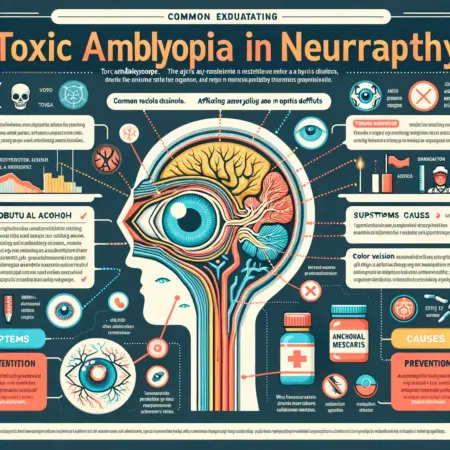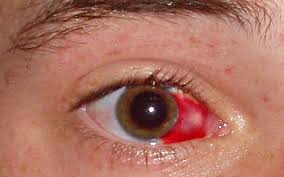Toxic amblyopia (nutritional amblyopia) is also called retrobulbar optic neuropathy which is damage of optic nerve.A remarkably uniform and stereotyped disorder of vision is encountered occasionally in persons who are chronically undernourished. Characteristically it evolves slowly and subacutely, the mode of onset of symptoms being much the same from patient to patient. Visual impairment usually starts insidiously and reaches a maximum in several weeks to months. Blurred or dim vision, difficulty in reading, photophobia, and retrobulbar discomfort on moving the eyes are the common presenting complaints.

On examination, the patient has bilaterally symmetrical central, centrocecal, or paracentral scotoma. Ophthalmoscopic changes are restricted at first to slight redness of the temporal margins of the optic discs; minimal pallor is observed at a later stage. Often, no abnormality is visible. The peripheral visual fields are usually intact. The visual disorder is, to a large extent, reversible with improvement of nutrition.
Pathology. The pathologic change in nutritional amblyopia consists of bilaterally symmetrical loss of myelinated fibers in the central parts of the optic nerves, chiasm, and optic tracts, corresponding in location to the papillomacular bundle. In severe cases, the retina loses macular ganglion cells, probably secondary to the “zonal” destruction of medullated fibers in the retrobulbar parts of the optic nerve.
Pathogenesis of Toxic Amblyopia.
This type of visual disturbance has been encountered in undernourished populations all over the world. It is commonly seen during famine, and among civilian and military prisoners of war: It is endemic in certain parts of Africa, Asia, and South America. Among the more privileged populations in the western world, the syndrome is seen in persons chronically addicted to alcohol or, occasionally, to tobacco, who neglect their nutrition. A similar syndrome also occurs as a complication of vitamin B12 deficiency and diabetes mellitus, as well as in patients treated with isoniazid for tuberculosis.
This visual disorder accompanies other neurologic syndromes believed to have a nutritional cause, such as Strachans syndrome, in which amblyopia is combined with paresthesias of the feet, hands, trunk, and, occasionally, face, loss of reflexes, dizziness, deafness, hoarseness, spasticity, ataxia, and a variety of mucocutaneous lesions (genital dermatitis, corneal degeneration, glossitis, arid stomatitis). In the chronic alcoholic patient, amblyopia may occur in conjunction with Wernicke’s disease, cerebellar degeneration, Marchiafava-Bignami disease, and peripheral neuropathy.
In recent years, a nutritional deficiency rather than a toxicity has been held responsible for so-called tobacco-alcohol amblyopia. Detailed clinical and pathologic studies fail to distinguish this type of amblyopia from nutritional amblyopia. In clinical experiments, patients with amblyopia continued their usual consumption of alcohol and tobacco, but ate an adequate diet supplemented by B vitamins. All showed some recovery of visual acuity and a reduction in the size of the scotoma.
As yet, the metabolic aberration or specific vitamin deficiency responsible for the development of amblyopia has not been defined. A lack of vitamin B12, thiamin, riboflavin, and pyridoxine or a failure in the detoxification of cyanide present in tobacco smoke, have been implicated in the genesis of the syndrome.
Except for isolated ‘findings of reduced serum vitamin B12 levels, the abnormal urinary excretion of methylmalonic acid arid low levels of blood transketolase activity, no specific biochemical abnormalities have been reported in cases of amblyopia.
Toxic Amblyopia Treatment Guidelines.
Treatment with oral or parenteral B vitamins and improved nutrition are usually followed by improvement, depending upon the severity of the amblyopia and its duration before therapy is instituted.
Toxic amblyopia in neuropathy, including its pathogenesis and treatment, can be explained in a tabular format as follows:
| Aspect | Toxic Amblyopia in Neuropathy |
|---|---|
| Definition | Toxic amblyopia, also known as nutritional optic neuropathy, is a condition where the optic nerve is damaged due to toxins or poor nutrition. |
| Causes | – Exposure to toxins such as methanol, ethambutol, or tobacco. \n- Nutritional deficiencies, particularly of B-vitamins like B12. \n- Alcohol abuse leading to poor dietary intake. |
| Pathogenesis | – Toxins or nutritional deficiencies lead to the damage of the optic nerve. \n- This damage impairs the transmission of visual information from the eye to the brain. \n- Cellular stress and mitochondrial dysfunction in the nerve cells. |
| Symptoms | – Gradual vision loss. \n- Reduced color vision, particularly red-green colors. \n- Central vision loss, leading to a central scotoma. |
| Diagnosis | – Patient history and symptoms. \n- Ophthalmic examination. \n- Blood tests for nutritional deficiencies. \n- Imaging studies like MRI to rule out other causes. |
| Treatment | – Elimination of the toxic substance. \n- Nutritional supplementation, especially B-vitamins. \n- Lifestyle modifications, including cessation of alcohol and tobacco use. \n- Regular eye exams to monitor progress. |
| Prognosis | – Varies based on the cause and promptness of treatment. \n- Early treatment can lead to partial or full recovery of vision. \n- Prolonged exposure to toxins may lead to permanent damage. |
This table provides an overview of the condition, its causes, how it develops, the symptoms, diagnostic methods, treatment options, and the general outlook for patients with toxic amblyopia in neuropathy.
